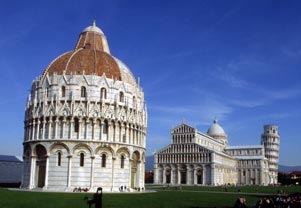La Piazza dei Miracoli
 The Cathedral Square is the heart of Pisa and the immortal symbol of the splendour and the power of the golden age of the Republic of Pisa. With its world famous monuments, the square can well claim to be the symbol of Italian art: it certainly is one of the best known and admired sights in the whole world.
The Cathedral Square is the heart of Pisa and the immortal symbol of the splendour and the power of the golden age of the Republic of Pisa. With its world famous monuments, the square can well claim to be the symbol of Italian art: it certainly is one of the best known and admired sights in the whole world.
The Cathedral Square is not in the center of the old town. On two sides the square is surrounded by the old city walls built in the middle of the XIIth century.Work on the piazza began a century before when the economical power of the town was at its peak. The piazza had been inhabited before by the Etruscan and then by the Romans: during the recent excavations for the preservation of the Leaning Tower some remains of the old settlements have been found.
If the Leaning Tower is certainly the most famous among the buildings of the Piazza, all the other buildings deserve the admiration of the visitor. First of all the imposing Cathedral, dedicated to the Assumption of the Virgin Mary
In the Piazza dei Miracoli, in an old medieval building that was once a monastery close to the Leaning Tower, there is still another well known museum, the Museo dell’Opera del Duomo; it contains many works of art that were once scattered in the four monuments of the Piazza together with a collection of sacred vessels, of old prints and of etruscan and roman archeological findings. You should not miss the islamic bronze grifon (XII century) (foto) whose copy is now on top of the cathedral’s apse; the Madonna with Child Jesus and Saints by Giovanni Pisano, originally on the main entrance of the Baptistry; the scuptures by Tino da Camino, once belonging to the tombs of Saint Ranieri and of Henry VI in the Cathedral; and finally the graceful Madonna del Colloquio by Giovanni Pisano.eri e di Arrigo VII poste in Cattedrale e la dolcissima Madonna del Colloquio di Giovanni Pisano.
The southern side of the Piazza del Duomo is closed by the regular and austere brick wall of the XIVth century hospital, now a museum the Museo delle Sinopie probably the only one of this kind in the whole world. Sinopie are the original preparatory drawings the the artist drew before painting the fresco. The sinopie exibited in the museum have been discovered and detached during the restoration of the frescos of the Camposanto. This collection of Sinopie is extremely interesting because the drawings, made by the great artists of the past, allow to follow the development of the artist’s conception of the work he would later paint.
